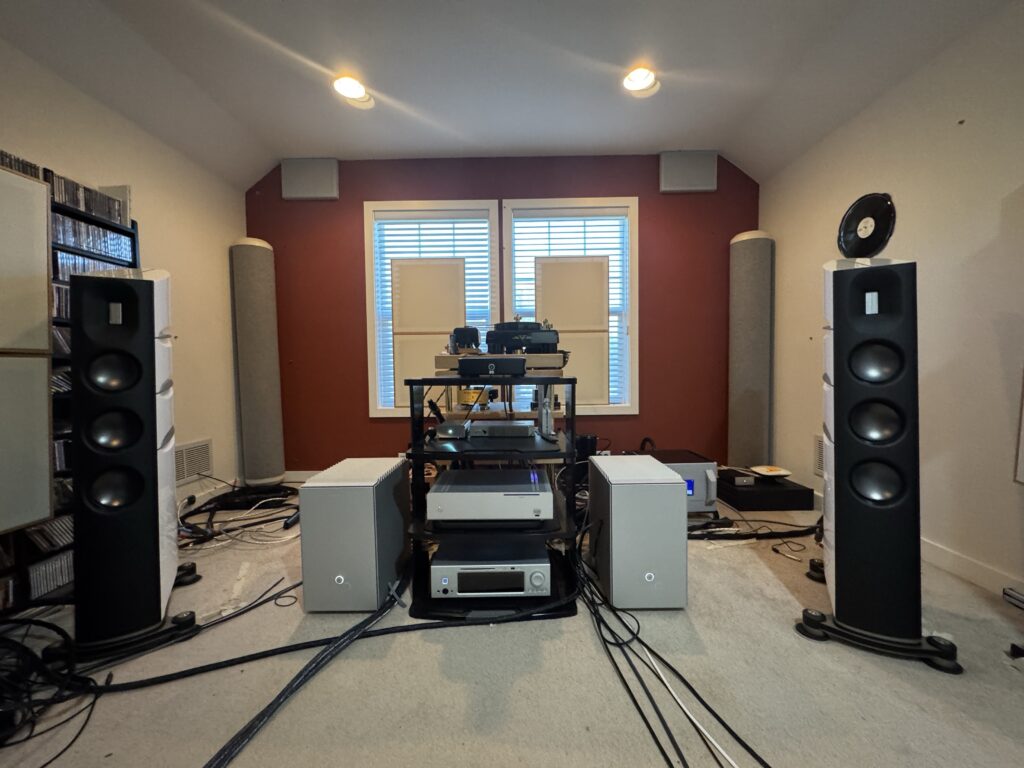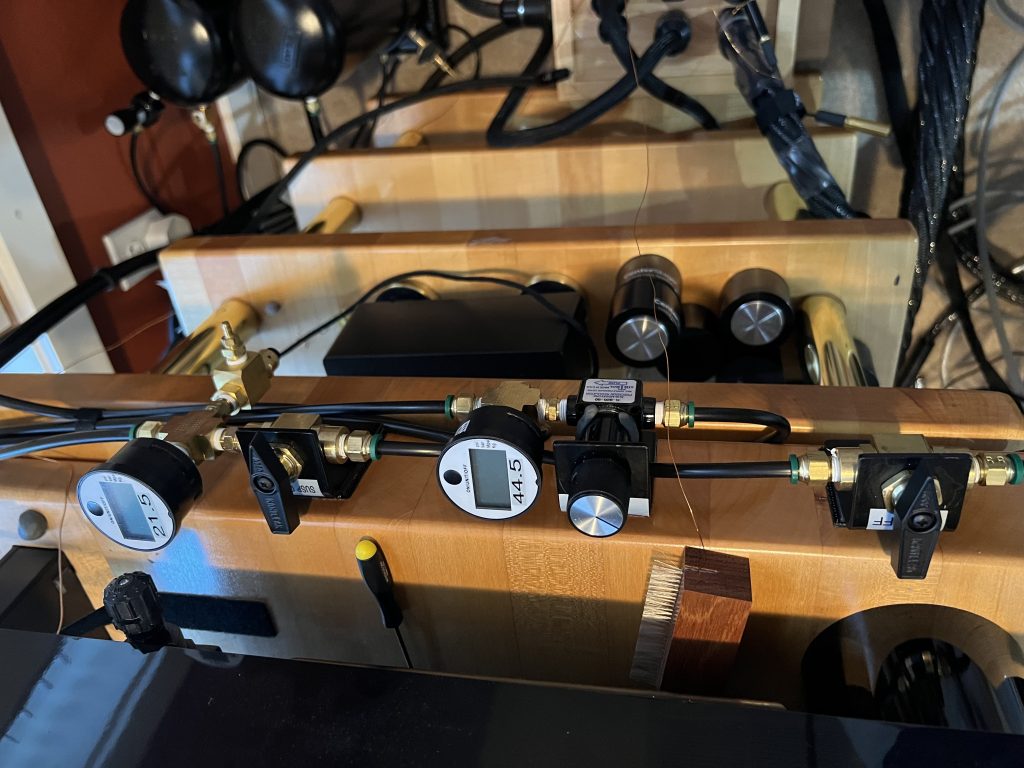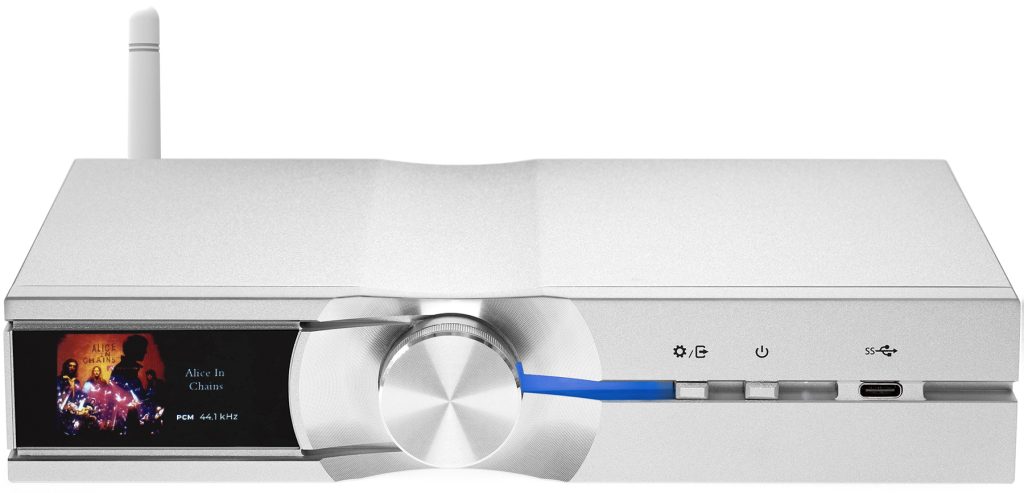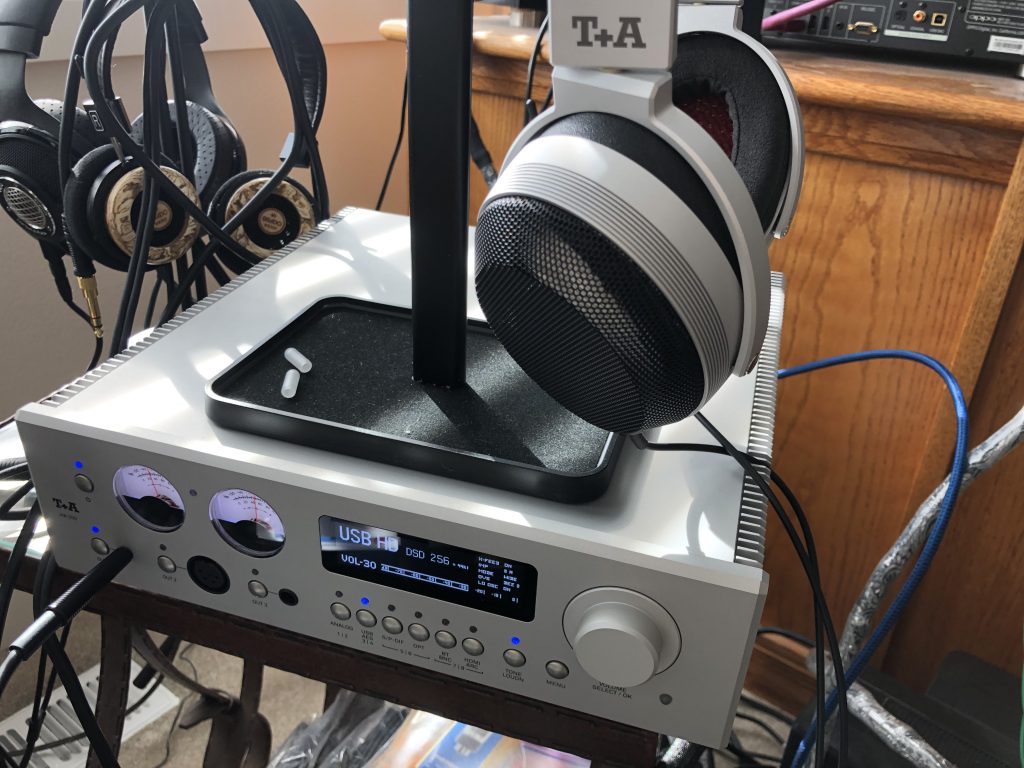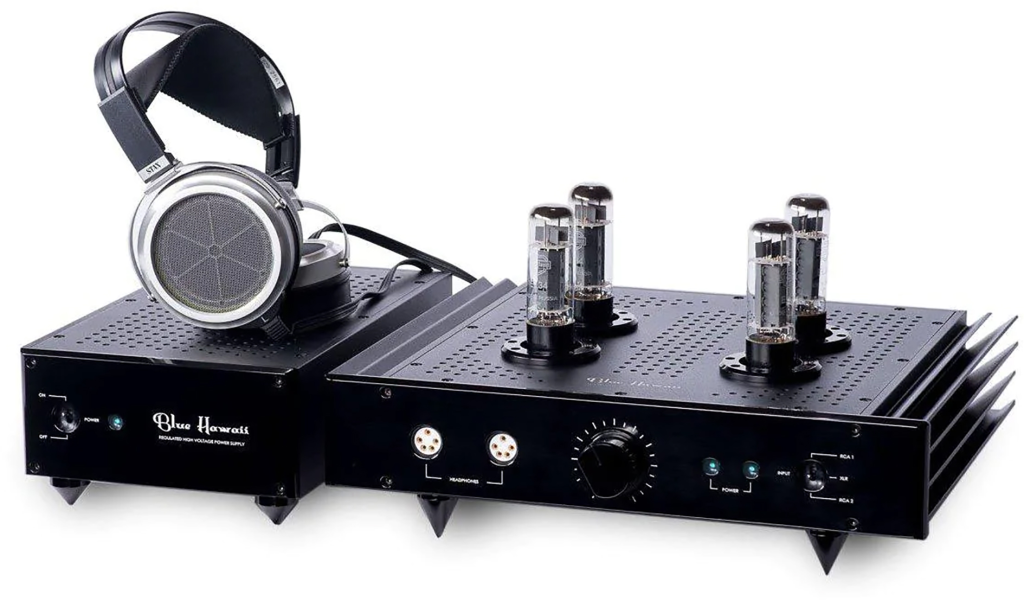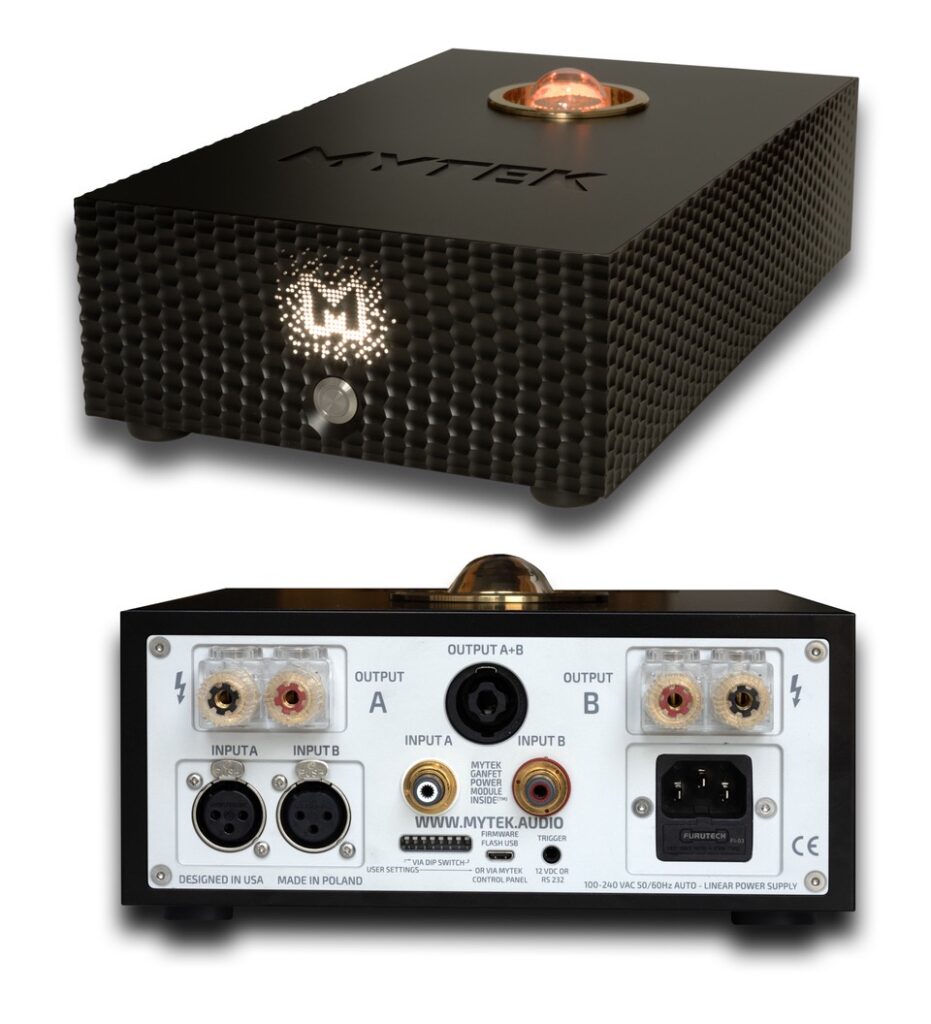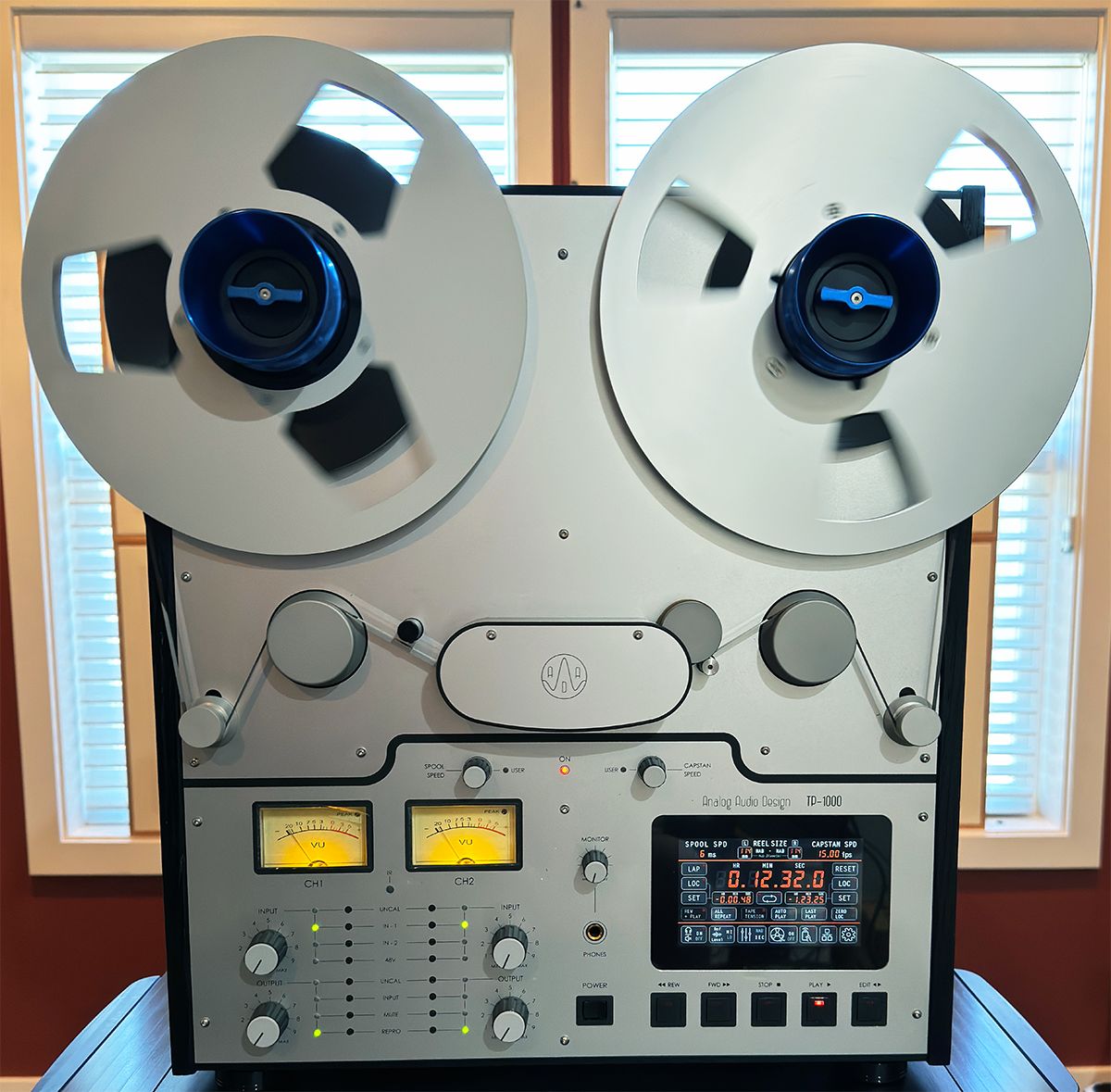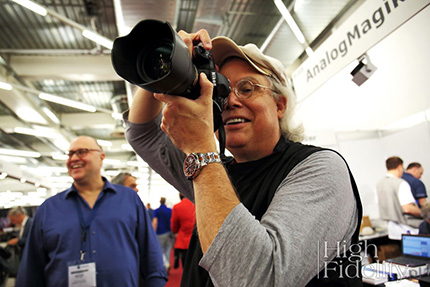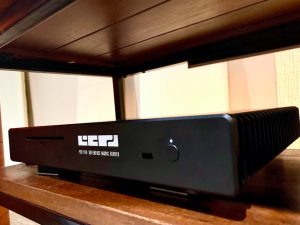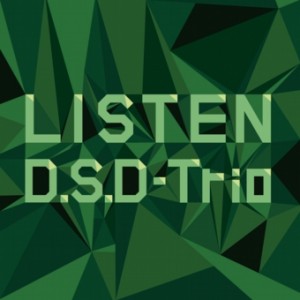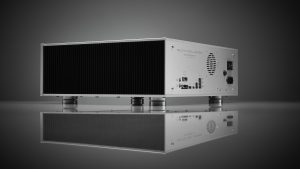
Ye Olde Editor in contemplation, pipe in hand, Happy Valley (portrait by John Robinson; image processing by David W. Robinson)
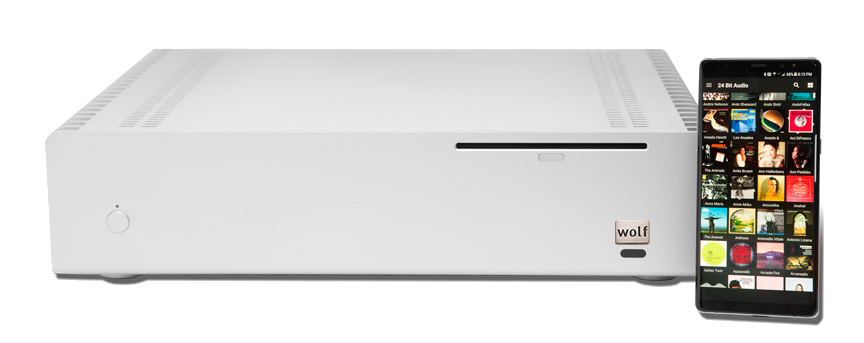
Wolf Audio's Alpha 3SX with its iPhone-based control interface
Time to say it again: we are in the golden age of high-end audio. I cannot think of a single category of "performance audio" that isn't much better now than it has been in past years (or decades). Turntables, loudspeakers, LPs, RTR tape machines, phono cartridges, SACD/DSD, cable technology, power conditioning/distribution technologies, streaming audio, portable audio/personal hi-fi, headphones, isolation racks/components, amps/preamps/phono amps, integrateds, system enhancements/tweaks…even the lowly CD player…all are the best they've ever been. Only perhaps in tube technology has there been a loss of alternatives, but the replacement/new models do seem to be providing new options for designers.
Among the products that are exploding in number and quality during the past 5-10 years have been digital music servers. I have been increasingly impressed by the growing excellence of these components, especially over the last 4-5 years. And during that time, major streaming alternatives like Qobuz (higher resolution .FLAC PCM) and TIDAL (MQA PCM) have come along to feed the streaming beast that has exploded all over the audio scene. (Not to mention Amazon Music, Apple Music, YouTube Premium, and others like Spotify, in various settings.)
Nearer at hand, there is a growing need to handle and playback the local digital resources of downloaded-and-stored DSD and PCM music on internal hard drives, external USB 3.0 hard drives, Solid-State Drives (SSD), and Network Attached Storage (NAS). Which is to say, the world of high-end audio is no longer a simple place. To handle these possibilities, audio designers have developed a number of products to process the playback of digital music files, involving a range of frameworks for getting the task done.
One of them is the subject of this revisitation essay: the Wolf Audio Systems Alpha 3SX Music Server. I gave it one of my 2020 Brutus Awards, based upon my initial very positive experiences with it.
But since then? Is the Alpha 3SX still good, or has it faded over time?
Let's dig in…how has it done over the past year of extended use?

The Alpha 3SX is a complex beastie. This is reflected in Joe Parvey's extended spec sheet.
Technical Specifications
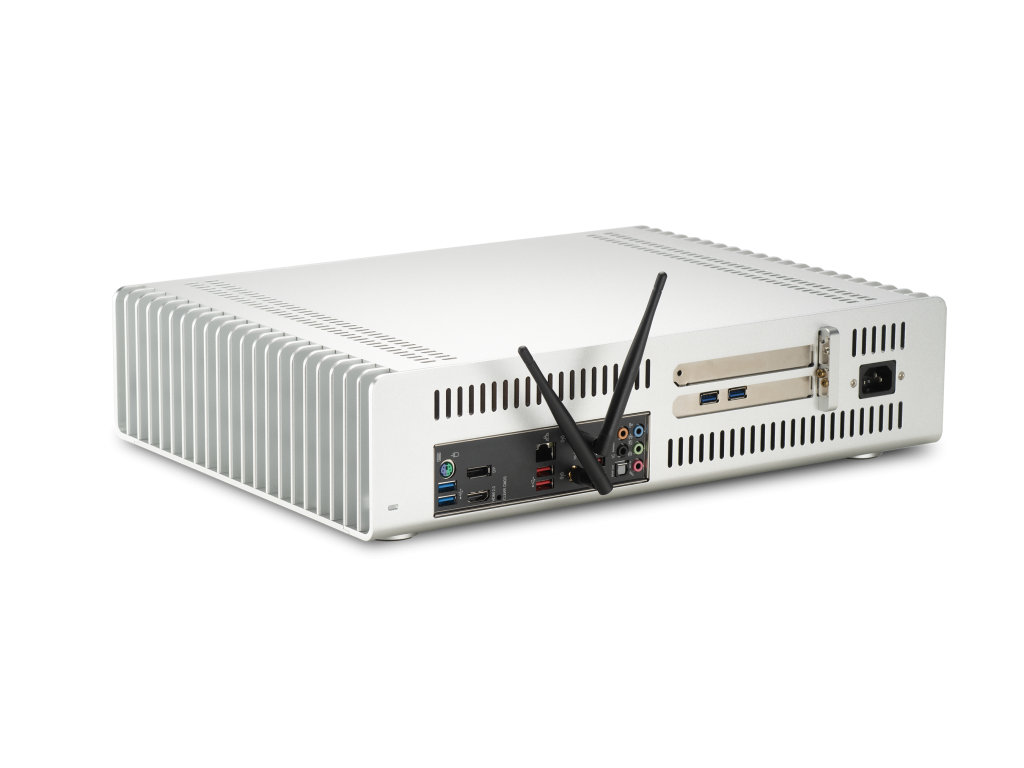
Digital Output
- Ultra-Low Noise USB 2.0 supporting USB Audio Class 1, USB Audio Class 2 and DSD (Native & DoP).
- Flux Capacitor 24MHz OCXO USB Card – 2 & 8 Channel Audio Clocking (Optional Upgrade).
- HDMI 2.0, DisplayPort 1.4. TOSLink Optical
Connectivity
- Ethernet & WiFi: 1x RJ45 Gigabit Ethernet – Network (Data & Audio) 802.11ac 1.73Gb/s WiFi
- USB: 2x USB 3.0/2.0 (DAC), 6x USB 3.0 (Mass Storage) 1x USB Type C – (Mass Storage & Future Module Connectivity)
- Video: 1x HDMI 2.0a – HDCP 2.2 and HDR, DisplayPort 1.4
- Physical Disc Formats: Red Book, DVD-A, DVD-V, BD-A, BD-V
- Disc Compatibility: CD, CD-R, CD-RW
- Audio format for stored CDs: FLAC, WAV, ALAC, OGG, APE, MP3, MPC,
- Streaming and Playing Formats: WAV, AIFF, FLAC, ALAC, AAC, MP3
- Sample Rates: PCM 44.1kHz – 1536KHz; bit depths 16-bit, 24-bit, 32-bit, 64-bit. DSD DSD64, DSD128, DSD256, DSD512, DSD1024
User Control Interfaces
- Web Interface: Web Browsers from iOS, Android, Windows and OS X browsers
- Mobile: App for iPhone/iPad, Android and Windows 10
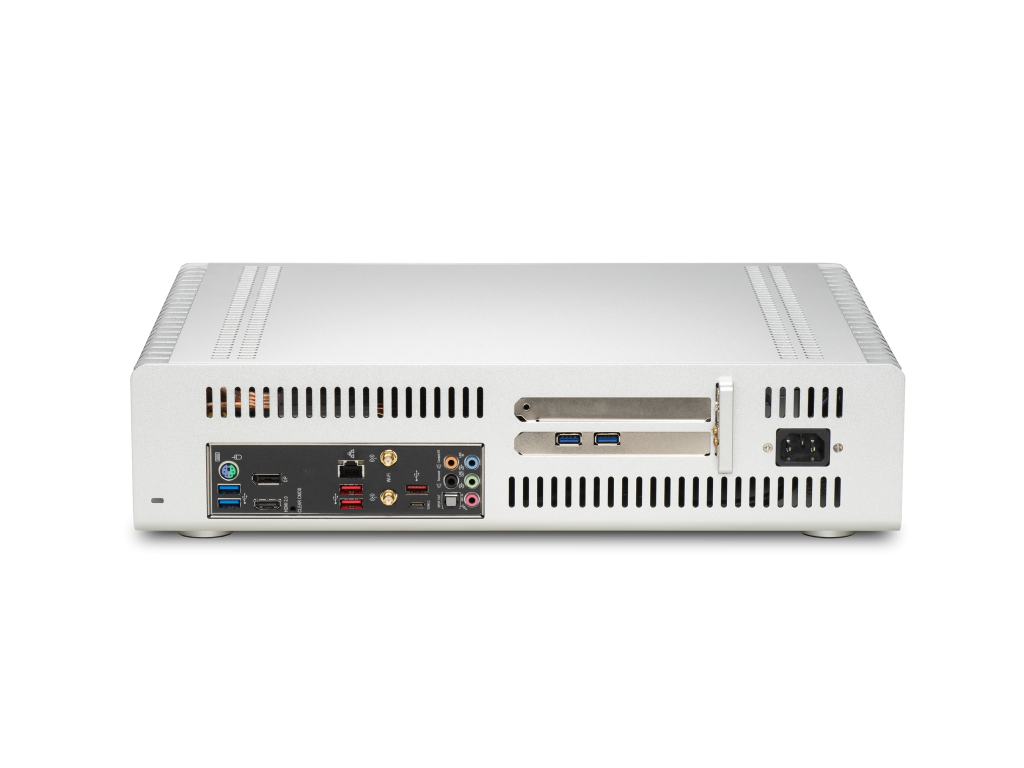
Hardware
- CD/DVD drive: TEAC Slot-load Blu-Ray drive
- System Drive: 1TB M.2 NVMe SSD – System
- Audio Drive: 2TB M.2 NVMe SSD – Audio Storage (expandable to 12TB)
- CPU: Intel Core i7-9700 Six-Core 3GHz
- Memory: 32GB DDR4 – (16GB Audio dedicated)
Streaming and CD Storage
- UPnP/DLNA: UPnP Server and DLNA Renderer
- USB: 2 Channel USB up to 32/384KHz DACs (USB Audio Class 1 and Class 2, DoP)
- Average CD Import Time: 5 minutes
- CD Metadata: Multiple CD metadata sources
Compatible Music Systems
- USB DAC
- SPDIF DAC (TOSLink)
- DLNA/UPnP compatible devices
- Network Players – Sonos, Denon HEOS, Oppo, etc
- Connected Receivers: Arcam, Anthem, Yamaha, Denon, Marantz, Sony, Onkyo, Pioneer, Datasat, Trinnov, and more.
- Smart Televisions: Sony, LG, Samsung, TCL, Sharp, HiSense, etc.
- HDMI Capable Devices (i2s, Multi-channel Audio, DTS-HD Master, Dolby Atmos, Dolby TrueHD)
- Receivers
- Televisions
- HDMI DACs
Requirements
- Network: Download artist and album metadata when ripping CDs, Internet Radio, Streaming Services and software updates. Network router with at least one available Ethernet port. Premium subscription required for some streaming services: Spotify, Qobuz and Tidal, etc.
- Music Controller: Remote control tablet app iPad, Android (Free and Paid versions available) or Web Browser – Most modern web browsers and platforms are supported
- DAC / Converter: DAC with USB input supporting USB Audio Class 1, USB Audio Class 2 or DoP protocols
Power
- Mains Supply: 100V, 110V, 220V AC – Internal Power Supply with noise regulation
- Power Consumption: 6W when idle, 150W peak
Physical
- Dimensions: Metric: 435 x 319 x 100mm (W x D x H, 109mm including feet) Imperial: 17.1" x 12.5" x 4.2" (W x D X H)
- Weight: 13 Kg, 23 Lbs
- In the box: Wolf Audio Systems Server. IEC (US), Mains Cable. 2m Ethernet Cable. WiFi Antenna
The Alpha 3SX is not only complex due to its capabilities, but also because of the fact that it is so highly configurable. Check the Wolf Audio Systems site and you'll see a number of options that can be added to the 3SX, to enhance its performance/connectivity.
After consulting with Joe Parvey, this is the setup that we settled upon for this evaluation back in 2020:
- i7-9700 CPU (a potent CPU…)
- 32GB 3000MHz RAM (…with lots of RAM!)
- 1TB System Drive
- 2TB Audio Drive (4TB Audio Standard on Pure Digital Edition) – Expandable to 48TB
- Power Portals for AC Filtration
- Stillpoints Isolators under critical componentry
- Constrained Layer Damping
- EMF/RFI Rejection Materials
- FluX Capacitor USB Clock Card
I opted to try the 22" external touchscreen monitor and keyboard/touch pad, just to get into an interface that was different from so many that use iPads/iPhones. (Change of pace and all that.) As configured above, the sample 3SX would retail at $12,295. Since prices vary according to the configuration you choose, and since there was a price increase last August, you'll have to check with Wolf Audio to see where your desired build would take your wallet.
BTW, I would be remiss if I didn't point out two elements in the Alpha 3SX that are of real significance.
One is the extensive use of Stillpoints Isolators internally for various of the circuit boards and internal components. I am a longtime user of Stillpoints Isolation devices, and have three of their ESS Isolation Grid Racks in service: two in our reference stereo listening room with the older grids, and one for our reference office system which features their newest grid rack configuration. Working directly with Stillpoints, Joe Parvey added their isolation devices in key locations to knock down internal vibration. I furthered this process by putting Stillpoints Isolation feet under the Alpha 3SX.
The other item that I should point out is the use of John Tucker's eXemplar Audio Power Portals inside the 3SX. These devices, developed in tandem with Joe's fine tuning of same, act as noise suppression devices within the music server. As Wolf Audio says in their Web site notes:
"Wolf and Stillpoints teamed up with eXemplar Audio to develop a new type of grounding and conditioning product to manage internal and external power noise. We call them Portals, and they operate in the mega and gigahertz spectrum, isolating and removing noise from the system. That noisy power can be transmitted via the positive, negative and neutral power lines. Using the Portal to siphon that noise out of the server helped the Alpha 3 SX reach a level of clarity and resolution that we typically associate with the Red Wolf 2 server."
Indeed. To have these two key elements incorporated into the Alpha 3SX shows extreme attention to detail. The degree of transparency, detail, and utter silence that I experienced speaks volumes of the design wisdom involved.
Because sometimes what you can't hear is just as important as what you can.
My main go-to during my listening was my longtime music-serving audiobud, JRiver's Media Center, which I've been using quite successfully for many years now. Joe Parvey favors MC 24 for the 3SX, although my Dell Precision Workstation is using the latest stable release, version 28. The system also supports the Roon and Audirvana+ systems. DSD is right up front, with handling up to DSD1024 (assuming that your DAC can handle DSD512 and DSD1024). MQA support is also included.
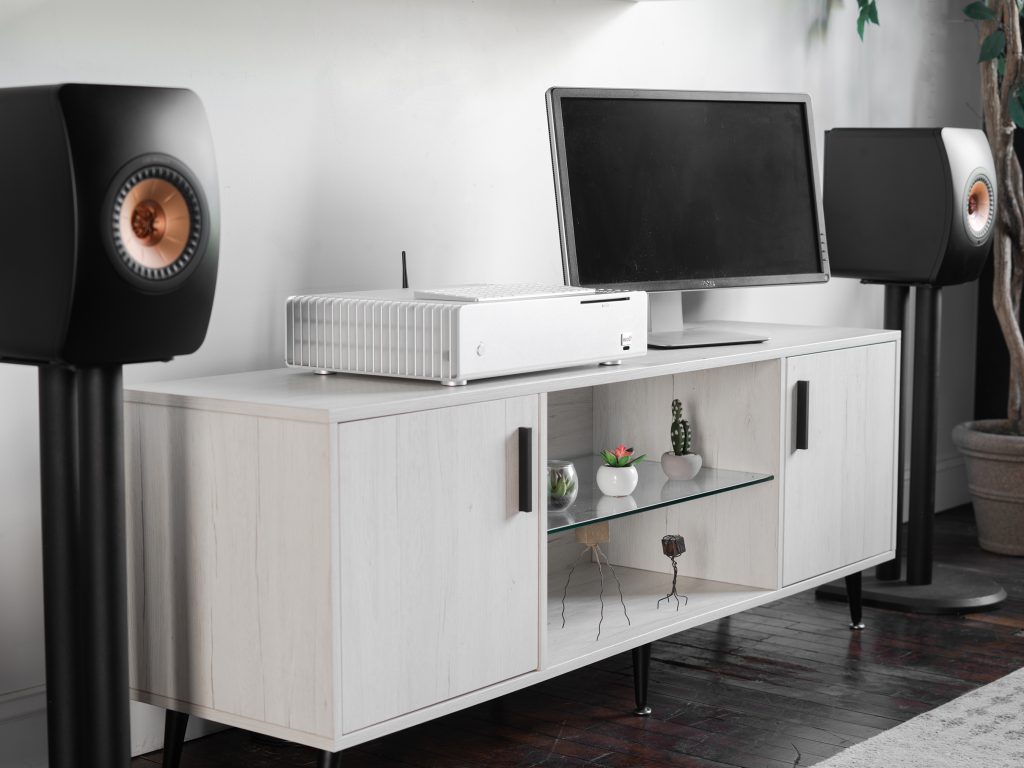
Unlike many of the Linux-based music servers, the OS is Windows 10, installed internally on a 1TB system drive, and optimized for audio playback. Media Center 24 runs on top as an application without a problem. In fact, upon bootup with the external monitor (see the photograph above; the 3SX has the 22" monitor on it), the 3SX brings up the familiar Windows 10 desktop, but then auto-opens Media Center so that you can go directly to your music files. This is where I camped out while listening over the past many moons in 2021.

Since I have terabytes of DSD (mainly) and PCM (some) on our local area network (LAN), plus the QNAP 1273U NAS (96TB of storage, less the recovery overhead for RAID 5, dropping effective capacity to 84TB), configured for me by Wolf Audio Systems (yes, they can do that for you too), I spent my time listening to LAN-based DSD recordings. I was particularly interested in how well the QNAP NAS storage would work with the Alpha 3SX.
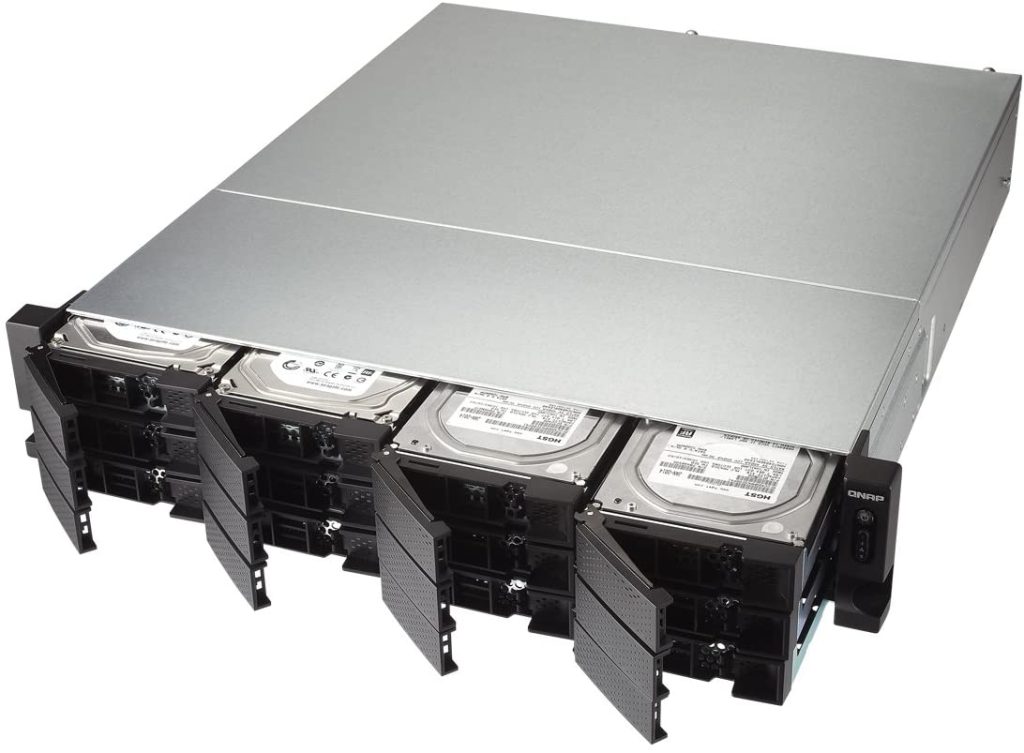
The setup
Joe Parvey was able to remotely assist in bringing up the NAS RAID 5 array and creating a DSD share file point in Linux, so that I could have a single point of origin for the megatons of DSD music that we have here. Once that was done, I spent several days copying files from various stand-alone hard disks that we have here in our PF archives. All went smoothly via our Cisco managed Ethernet switch stack, and I was able to start listening immediately thereafter.
One of the big advantages of Internet-based Ethernet music servers is that they can be remotely accessed in a secure fashion, and configuration/tech support assistance rendered. The combination of a Windows 10 platform with remote software allows help directly from Wolf Audio Systems in minutes. I've spent many years wearing an Information Technology hat, and have done this sort of thing professionally myself. Therefore, I can tell you that the Wolf Audio team is highly skilled, and handled some final squaring away of our new NAS very effectively. Nice work, Joe Parvey!
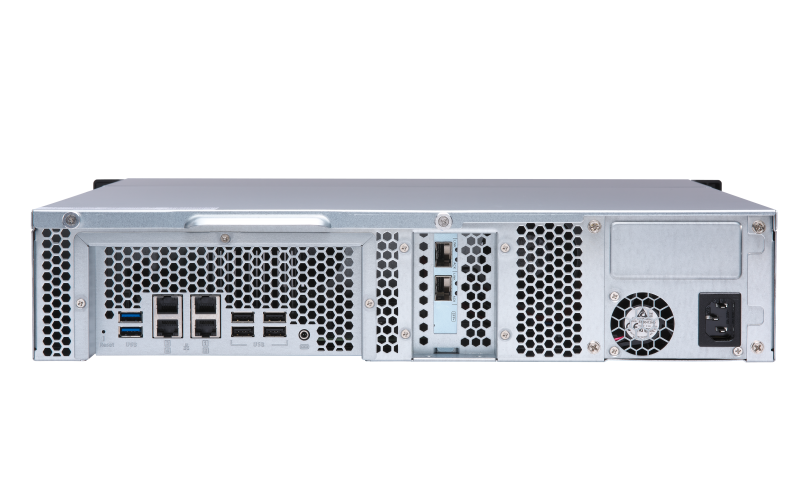
By the way, the fact that we now have a RAID 5 array lends an extremely important layer of safety for our files. With RAID 5, if a single hard drive in the array fails, no data is lost, unlike stand-alone hard drives. I strongly recommend that if you have a large collection of digital music in whatever format on a stand-alone/non-RAID hard drive storage system, that you undertake the research necessary to find a RAID solution. Joe Parvey and Wolf Audio Systems can help you with that; give them a call to explore your options.
So, now all digital music playback resources are now able to access our QNAP 1273U NAS anywhere on our LAN without a problem. In fact, I use Roon all the time to connect there for DSD playback on our outdoor reference system, with results that are most excellent!
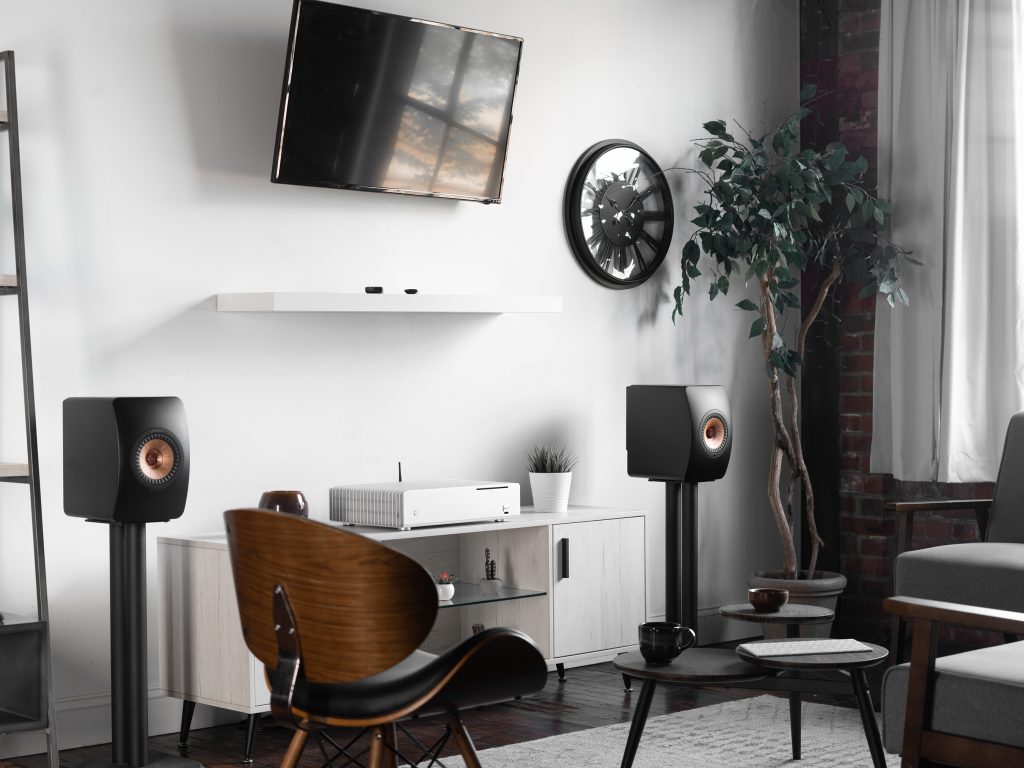
Note that the Alpha 3SX is a Music Server, which means that it does not feature a DAC function. All DACs are external devices, supported via USB output from the 3SX. During the time that the 3SX was here, we were able to use two different exceptional DACs with it: Ideon's The Absolute version 1…now in version 2 with improved capabilities, and the aqua acoustic Formula xHD Revision 2.
In each case, a quick remote setup session got the DAC online with the Alpha 3SX, with no operational problems. Since this is a Windows 10 platform, he simply loaded the necessary ASIO driver, initialized it, and we were ready to go. I can do this on my own…I've done it countless times…but since Joe was intimately acquainted with the internals of the Alpha 3SX, I decided to let him handle the process.
I used the optional 22" monitor with an associated optional keyboard/touchpad, both supplied by Wolf Audio as part of the total package. Because I am quite experienced with JRiver's Media Center, operating playback was a breeze.
The system
The 3SX has been used in tandem with the following components since its arrival in 2020:
- Ideon The Absolute DAC, version 1, and aqua acoustics Formula 1 xHD Rev. 2 DAC
- Merrill Audio Christine Preamp
- Merrill Audio Element 118 Monoblock Amps
- Cabling by Kubala-Sosna and Synergistic research (in succession)
- Synergistic Research PowerCell SX
- Isolation stands by Critical Mass Systems and YG Acoustics (in succession)
- VIVID GIYA G1 S2, Raidho TD 3.8, and YG Acoustics Sonja 2.3i loudspeakers
The Sound
With all of that behind us now, we now come to the heart of the issue: how did the Alpha 3SX do with this excellent supporting cast over the past 1.5 years, which provided a reference-level setting in several iterations?

This is an easy call. The Alpha 3X/Media Center combination provided a remarkable experience at all resolutions of DSD, running from SACD-standard DSD64 (single DSD) all the way up to the limits of the associated DAC. This was DSD128 in version 1 of the Ideon The Absolute DAC that we had at the time, while the aqua Formula xHD Rev. 2 went up to DSD512. (Ideon has now come out with a version 2 of The Absolute that now goes out to DSD512.)

The sheer transparency and detail of the presentation of the Alpha 3SX was notable, being extremely good at the DSD64 level, but was especially tasty at DSD128 level with the Ideon, as I commented in my Brutus Award for it in 2020. We have a very large number of excellent reel-to-reel transfers, needle drops, and recordings in our DSD128 file section. This made for a very solid diet for The Absolute.
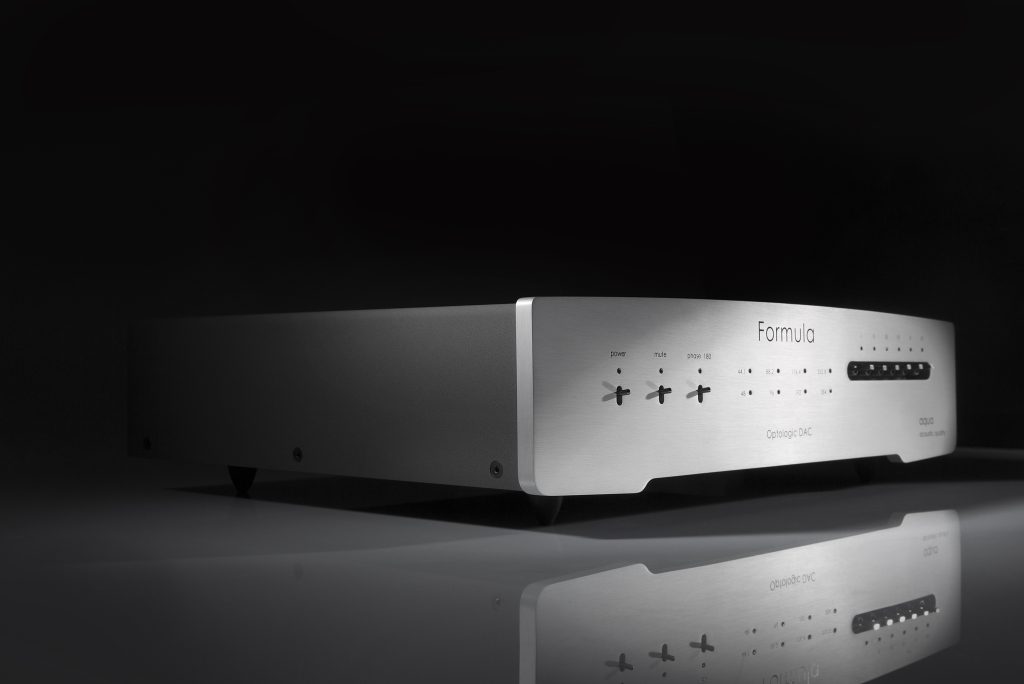
aqua acoustics' Formula xHD Rev. 2 (about which, more shortly) supports DSD512, which is clearly better than the lower resolutions, though the margin gets smaller and smaller as you go from DSD64 to DSD128 (a significant leap) to DSD256 (another quite definite improvement to my ears) in comparison. Tom Caulfield at NativeDSD.com has become quite expert in remodulating DSD256 to DSD512, which is the only way that you can obtain this resolution at the current time. I would recommend that you try the DSD512 albums over at NativeDSD if your DAC will handle this resolution; the discernable differences are quite gratifying to my ears…at the cost of file sizes that double over those of DSD256, of course. (Get that NAS.)
I gave the Formula xHD Rev. 2 a Brutus Award back in 2020. Since I have final notes on it coming out shortly, I'll reserve my specific observations about its audio virtues for that article. Nevertheless, I can say that the Formula xHD Rev. 2 is a top-notch performer, providing a silky, elegant, and nicely transparent presentation, regardless of source or genre. The dynamics are fantastic, too. "It don't mean a thing if it don't got that swing!"
The Alpha 3SX mated with the Formula xHD Rev. 2 just as readily as it had with the Ideon The Absolute. Joe did a quick remote session to be it online, and it just worked after that. The Alpha 3SX showed itself to be a real audio chameleon as a music server, allowing the sonic qualities of the outlying DAC to simply shine through. This is an extremely important characteristic of a superior server: it should be as neutral as possible, and let the DAC do its job. With the Alpha 3SX, these two excellent DACs could be differentiated from one another, and their characteristics appraised without having to be concerned about the signature of the intermediary server. That's a major strength with the Alpha 3SX.
Sonically, and regardless of which of the two DACs that we used with the Alpha 3SX, I was really taken by the clarity, detail, and notable transparency of the Wolf Audio music server. It slipped hand-in-glove with either of these DACs, and seemed to bring out the best of either one. With such a powerful Windows 10 platform and the JRiver Media Center operating quite synergistically…no surprise, since I've used that combination with a number of different computers over quite a few years now…I heard no problems (drop-outs or pops) and could revel in the music without anticipating interruptions. All Windows updates, always a concern with Windows-based music servers, worked without hassle at this end.
Sources, for the record (yes, perhaps a pun)...
As I mentioned, I concentrated on LAN- and NAS-based resources with the Alpha 3SX, treating it as a true music server, and not as a streamer. Thus, my comments above focus on those possibilities, primarily in DSD format.
The PF DSD library includes a megaton of DSD rips from SACD, some DSD128 transfers from RTR tape and needle drops from LP, DSD256 from various online sources (mainly HDTT and NativeDSD.com) and some DSD256 transfers from RTR tape that I've done here via the Merging Technologies Horus A/D, as well as some of the more experimental remodulated DSD512 and even DSD1024 from NativeDSD.com. (Note that neither of the DACs that we've used so far support DSD1024, however.) Also aboard are some unobtainium DSD recordings from RTR tape that—if I told you about them—I'd have to kill you. So, sorry.
All have been accumulated over a number of years, their musical quality speaks for itself, and are constant references here. Frankly, there are simply too many sources to go over here. The variety listed above gives you a sense of the very broad range of sources here, representing many genres of music, all of which were used extensively with the Alpha 3SX over countless hours with several iterations of system components. The results were uniformly outstanding, regardless of resolution or type.
Quick sum...
In the Wolf Audio Systems Alpha 3SX, we have a highly versatile music server that should work well in for most audiophiles. (Though perhaps Mac users would give the Windows interface a pass.) It's powerful, quite configurable, sounds terrific with the reference-level DACs that I tried, and intelligently designed. Its compact form factor should be a real draw for those whose space is constrained, but are still looking for audio excellence.
Roon compatible? Check.
Remote control apps for Apple and Android. Got it.
Massive available extra storage capacity? Yep.
A Blu Ray Drive (this is rare in rippers) that rips not only CDs, but also DVD-As, BD-As, several PCM formats from disc, as well as Apple music formats? Oh yeah.
Works and plays well with Qobuz and TIDAL (well, OK...Spotify too)? Indeed.
Not only that...it's very attractive to look at. A classy chassis!
Damn! What an achievement! My hat is off to Joe Parvey.
Coming good news
As if the Alpha 3SX weren't brilliant enough, Wolf Audio Systems is bringing out a new version of its top-of-the-line product, the Red Wolf 2, which is two-box system with separate power supply. The new model will be named the Red Wolf 2SX. Joe Parvey says that it will be quite remarkable, incorporating new developments and design ideas that should really make it a fire-breathing contender in the music server market.
Joe has promised to send me a review sample when the time comes. The Alpha 3SX will return to him; the Red Wolf 2SX will stay here.
There is no official release date yet. I'll keep you posted as we know more.
Conclusion
My extended time in 2021 with the Wolf Audio Alpha 3SX Music Server has underlined and strongly confirmed my initially very favorable impressions with Joe Parvey's extraordinary design.

Joe Parvey with his father Fred: unindicted co-conspirators! (Photograph and image processing by David W. Robinson)
A combination of really serious available processing power, sophistication of internal components, well-integrated physical and electrical isolation, flexibility, ease of remote support, the familiarity of the Windows 10 interface, and compatibility with various Windows 10 ASIO driver systems makes the Alpha 3SX a world-class player in the high-end music server segment. And to seal the deal, the Alpha 3SX Music Server has sounded superb with the both of the associated DACs that we've tried, all of the associated electronics and loudspeakers we've used, and is very attractive to look at, to boot. This is a killer music server, amigos!
And so I can say with complete confidence that the Wolf Audio Systems Alpha 3SX richly deserved the Brutus Award that I gave it in 2020, and has performed so well over time with a variety of sources over time to allow me to do a very rare thing: give it a new Brutus Award for 2021 - 2022. I do so enthusiastically.
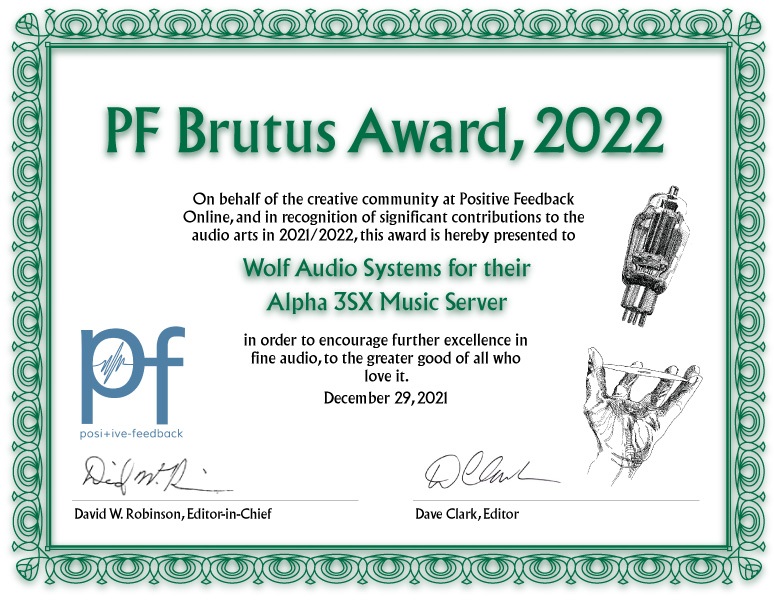
Yes, it's that good.
If you can afford the price range for a music server, then the Alpha 3SX must be on your very short list of candidates.
Price: Base price as of time of publication: $9,295. Final price depends on the configuration/upgrades that you choose. Contact Wolf Audio Systems for current options and pricing in 2022.
Wolf Audio Systems
234.770.0660, 8AM – 8PM Eastern Standard Time
Product photography courtesy of their respective companies. Other photographs as noted.




